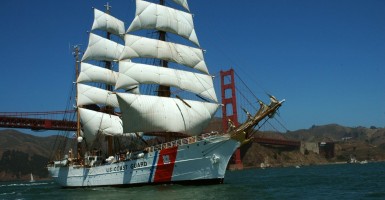On this day in 1790, Congress passed an “Act to create the Revenue Cutter Service,” which authorized then-Secretary of the Treasury Alexander Hamilton to build a number of vessels to enforce customs laws.
With this allocation, Hamilton commissioned the construction of ten “revenue cutters” intended to patrol key U.S. ports and ensure the safe and secure passage of goods to enable the growth of commerce in the new nation.
This small fleet became the precursor to the modern U.S. Coast Guard.
As Hamilton wrote to the first commanding officers of this service, “the province of the Revenue Cutter [is] to guard Revenue laws from all infractions, or breaches, either upon the coasts or within the bays, or upon the rivers and other waters of the United States.”
As America’s commerce grew, so too did the responsibilities of this new service.
The Revenue Cutter Service was responsible for protecting against piracy in U.S. waters, as evidenced in the early 1800s, when the cutter Louisiana captured numerous pirate ships near New Orleans and in the Caribbean.
A key statutory mission of the Coast Guard today is interdicting narcotics bound for the U.S.
The first recording of such action took place on August 31, 1890, when the Revenue Cutter Wolcott seized an American vessel that was smuggling undeclared opium.
Today, the Coast Guard continues to seize contraband such as cocaine on a near daily basis.
As the nation expanded geographically as well as economically, the Coast Guard assumed greater responsibilities as well.
The sea service began ice operations in 1867 with the purchase of the Alaska territory, when the Revenue Cutter Lincoln performed patrols in Arctic waters.
The Coast Guard has operated in the adverse conditions of the High North ever since and continues to do so today as the Arctic generates increasing economic potential.
The Coast Guard has also deployed to combat zones throughout American history.
When the U.S. Navy was established in 1794, the Revenue Cutter Service was issued guidance to support naval missions.
In the War of 1812, the cutters supported the new, undersized Navy, particularly in performing coastal patrols.
During the Vietnam War, the Coast Guard played an integral part in “Operation Market Time,” a coastal surveillance mission that sought to prevent the North Vietnamese from infiltrating South Vietnam through waterways.
During both Operation Desert Storm and Operation Iraqi Freedom, the Coast Guard provided port safety and security in the Persian Gulf and other volatile waters that were crucial to logistics and supply of U.S. troops.
Throughout its rich history, the U.S. Coast Guard and its founding organizations have provided critical security that exemplifies the Preamble to the Constitution’s pledge to both “provide for the common defence” by patrolling U.S. waters and supporting the other armed services and to “promote the general welfare” by facilitating the free flow of goods and services along America’s coasts and in its waterways.
Yet as its missions grow in breadth, the Coast Guard’s capacity to execute them has not kept pace.
The sea service’s fleet is aging and undersized.
Congress should continue to support the recapitalization of the Coast Guard to ensure that it can continue the legacy of the Revenue Cutter Service in safeguarding the nation’s maritime interests.





























